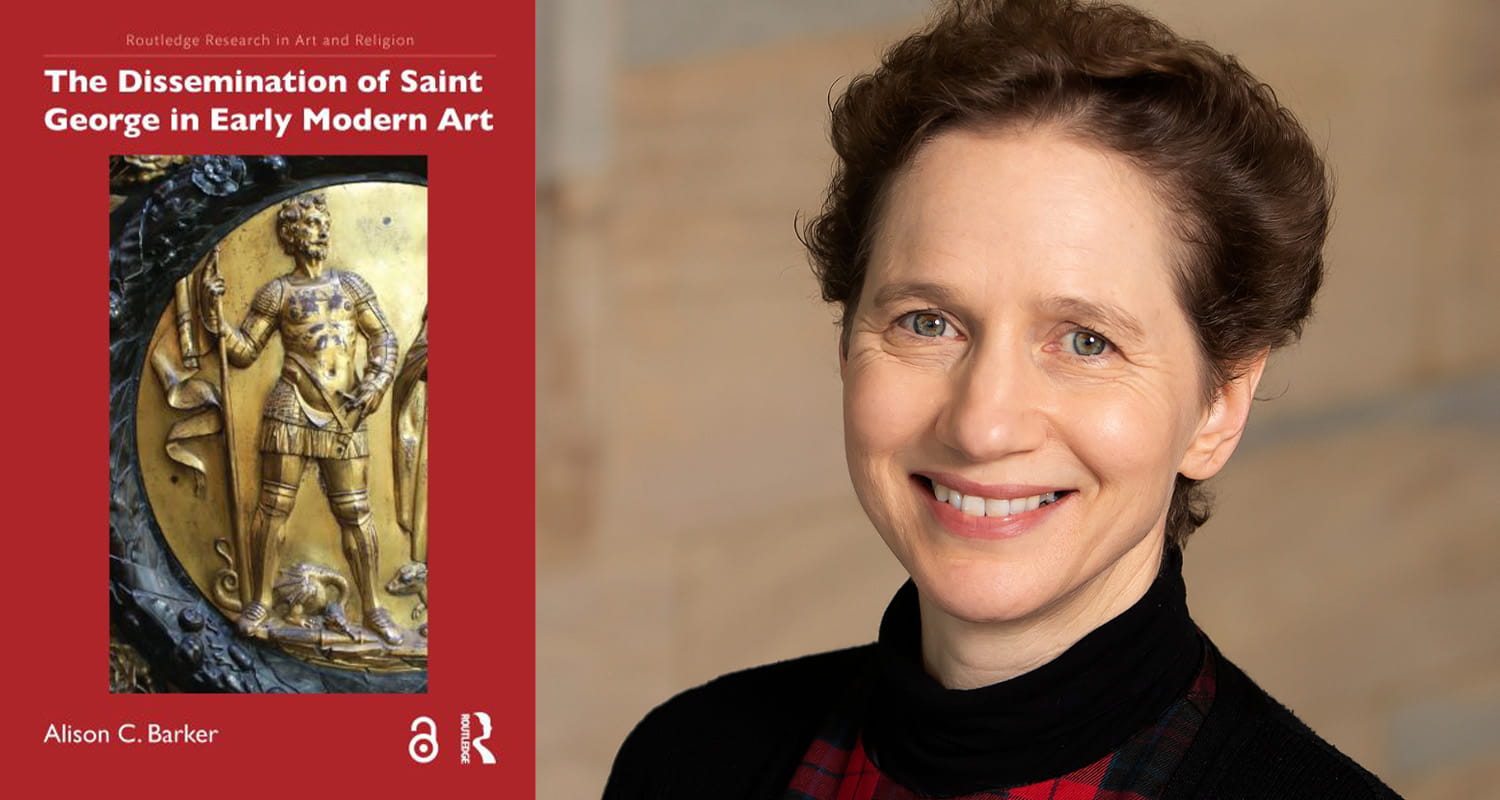Dr Alison Barker is the latest member of staff to have published new research with the backing of the University’s Open Access Fund.
Her book The Dissemination of Saint George in Early Modern Art has just been published by Routledge in its prestigious Routledge Research in Art and Religion series, and thanks to Open Access it can be downloaded and read in its entirety free of charge.

Congratulations on the publication of your book! How does it feel?
Thank you so much. It feels amazing! It is the culmination of over seven years work, so it feels like a huge achievement.
You chose to make use of the University’s open access fund. Why is Open Access important to you?
While I was doing my PhD I often came up against the difficulty of not being able to read a book or article that I needed for my research. There was a fee for reading those texts, and I found this really frustrating.
I think it is extremely important for research to be freely available and accessible for all, no matter how much you have available to spend. Learning, education and academia should be inclusive and I think that Open Access creates the environment for this to happen.
Do you use Open Access materials in your own teaching or research?
Yes – all the time.
What advice about Open Access or publishing in general would you offer to colleagues?
Firstly, get help and advice from our lovely Library Open Access team!
I would also recommend carefully researching the market for your book or article. When sending in your Book Proposal it will save time and possible rejections, if you can target who is most likely to want your book.
Look at different publishers and think how your work would fit with them. I went straight to Routledge because their Research in Art and Religion Series seemed to be just where my book would fit… and it did.
Now, to your work. What first drew you to Saint George as a subject for your research?
I was on holiday in Venice visiting the Scuola Dalmata, which is a bit like a Guildhall in England, and the walls were decorated with large canvases.The subject of three of them was Saint George and I said to my husband, "What is Saint George doing here, he’s English!" I hadn’t realised, in my ignorance, that he is not English at all, but actually has Turkish origins. However, here he was on a wall in Italy, looking exactly like we would expect Saint George to look. That made me wonder how he had come to be in Italy and why his appearance was almost identical to the Saint George I knew. That was in 2013, and ever since then I have been trying to answer that question.
Your book focusses on Saint George in the early modern age. Why did you choose this period?
I have always been drawn to the history and the art of the fourteenth, fifteenth and sixteenth centuries. There is something about this time and culture that really intrigues me.
I could quite happily have covered the entire period, but I had to limit myself to only one hundred and fifty years! Of course, even that time period includes many different styles and types of art so it is very varied.
One central theme of your book is how Saint George could mean very different things to different audiences. Can you give us some examples?
Yes. I structured the book around four different audiences to illustrate how, although Saint George appears visually the same, he does mean different things to the people who are viewing him. One example is that of princes and rulers, who utilised Saint George in their self-fashioning, basically using him as an advert. Because Saint George was a warrior-saint he appealed strongly to the rulers of the fifteenth and sixteenth centuries. I argue that he would be held up as a mirror for rulers to look into and see themselves reflected, and then to reflect back to those they wanted to impress. For example, Maximilian I commissioned a portrait of himself in the guise of Saint George, embodying the qualities of holiness, courage, piety and victory that were called to mind on seeing the saint.
Images of Saint George also meant something different to the three remaining audiences that I discuss - artists, guilds and pilgrims.
The Reformation is very close to what’s often seen as the start of the early modern period. What impact did it have on representations of Saint George?
Interestingly, because Saint George was a patron saint of England and linked very much to the monarch, images of him still abound during the Reformation. Pilgrimages, however, did not continue due to the injunctions brought in both by Henry VIII and Edward VI, meaning that pilgrim badges ceased to be made.
In Italy and Germany, the situation was different due to the way the Reformation was implemented there, and Catholicism continued strongly in the Italian city states throughout the period in question with images of saints, including Saint George, flourishing.
It’s an extremely well-illustrated book: did publishing open access make any difference to which illustrations could be included?
Thank you – the images are key to the arguments in the book, so it was very important to me that as many as possible were included. Routledge have a specific maximum number of images that they will publish in a physical book, and that is what I went for. I don’t actually know if publishing Open Access made a difference to this or not.
And do you have a favourite?
That is a very hard question, as I am fond of all the images, but the image I chose for the cover is very important for me and probably my favourite. It is one of the roundels on the side of Henry VII’s tomb in Westminster Abbey’s Lady Chapel. It shows Saint George with his dragon beneath his feet and was created by an Italian sculptor, Pietro Torrigiano in about 1512.
This image has some very special memories for me, as my husband and I were given permission to enter the tomb enclosure itself to take the photograph and were, therefore, able to view it from close up. It is also a key image because it examines the idea of the transference of Saint George images across borders – in this case from Italy to England.
If I was allowed a second favourite image, I would go for the dynastic portrait of the family of Henry VII on page 33, where Saint George fights a flying dragon above the battlements of Windsor Castle. It is full of colour, symbolism and messages of power, and resonates with the themes of my book about how George was used in different ways by different people.
What’s next for you now? Do you have any new projects lined up?
Yes – my next main project is a paper for the Renaissance Society of America’s Conference in Boston, MA, held in March. I will be focusing on a little known, English, multi-media sculpture of Saint George made in about 1500. It is an incredible group which I couldn’t include in my book, so I am very excited about bringing it to the attention of the Art History community.
The Dissemination of Saint George in Early Modern Art (Routledge, 2025) is freely available to download now.
The Open Access Fund
The University of Essex's institutional Open Access Fund enables Essex authors to publish their research open access and to share their findings without barriers. You can explore your Open Access options with our dedicated forms: for longform works such as books and chapters, and for articles.




